FlexPod Datacenter with VMware vSphere 6.7 U2, Cisco UCS 4th Generation Fabric and NetApp ONTAP 9.6 Design Guide
Available Languages
Bias-Free Language
The documentation set for this product strives to use bias-free language. For the purposes of this documentation set, bias-free is defined as language that does not imply discrimination based on age, disability, gender, racial identity, ethnic identity, sexual orientation, socioeconomic status, and intersectionality. Exceptions may be present in the documentation due to language that is hardcoded in the user interfaces of the product software, language used based on RFP documentation, or language that is used by a referenced third-party product. Learn more about how Cisco is using Inclusive Language.
- US/Canada 800-553-2447
- Worldwide Support Phone Numbers
- All Tools
 Feedback
Feedback
FlexPod Datacenter with VMware vSphere 6.7 U2, Cisco UCS 4th Generation Fabric and NetApp ONTAP 9.6 Design Guide
Published: February 2020
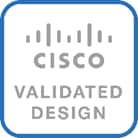
In partnership with:

About the Cisco Validated Design Program
The Cisco Validated Design (CVD) program consists of systems and solutions designed, tested, and documented to facilitate faster, more reliable, and more predictable customer deployments. For more information, go to:
http://www.cisco.com/go/designzone.
ALL DESIGNS, SPECIFICATIONS, STATEMENTS, INFORMATION, AND RECOMMENDATIONS (COLLECTIVELY, "DESIGNS") IN THIS MANUAL ARE PRESENTED "AS IS," WITH ALL FAULTS. CISCO AND ITS SUPPLIERS DISCLAIM ALL WARRANTIES, INCLUDING, WITHOUT LIMITATION, THE WARRANTY OF MERCHANTABILITY, FITNESS FOR A PARTICULAR PURPOSE AND NONINFRINGEMENT OR ARISING FROM A COURSE OF DEALING, USAGE, OR TRADE PRACTICE. IN NO EVENT SHALL CISCO OR ITS SUPPLIERS BE LIABLE FOR ANY INDIRECT, SPECIAL, CONSEQUENTIAL, OR INCIDENTAL DAMAGES, INCLUDING, WITHOUT LIMITATION, LOST PROFITS OR LOSS OR DAMAGE TO DATA ARISING OUT OF THE USE OR INABILITY TO USE THE DESIGNS, EVEN IF CISCO OR ITS SUPPLIERS HAVE BEEN ADVISED OF THE POSSIBILITY OF SUCH DAMAGES.
THE DESIGNS ARE SUBJECT TO CHANGE WITHOUT NOTICE. USERS ARE SOLELY RESPONSIBLE FOR THEIR APPLICATION OF THE DESIGNS. THE DESIGNS DO NOT CONSTITUTE THE TECHNICAL OR OTHER PROFESSIONAL ADVICE OF CISCO, ITS SUPPLIERS OR PARTNERS. USERS SHOULD CONSULT THEIR OWN TECHNICAL ADVISORS BEFORE IMPLEMENTING THE DESIGNS. RESULTS MAY VARY DEPENDING ON FACTORS NOT TESTED BY CISCO.
CCDE, CCENT, Cisco Eos, Cisco Lumin, Cisco Nexus, Cisco StadiumVision, Cisco TelePresence, Cisco WebEx, the Cisco logo, DCE, and Welcome to the Human Network are trademarks; Changing the Way We Work, Live, Play, and Learn and Cisco Store are service marks; and Access Registrar, Aironet, AsyncOS, Bringing the Meeting To You, Catalyst, CCDA, CCDP, CCIE, CCIP, CCNA, CCNP, CCSP, CCVP, Cisco, the Cisco Certified Internetwork Expert logo, Cisco IOS, Cisco Press, Cisco Systems, Cisco Systems Capital, the Cisco Systems logo, Cisco Unified Computing System (Cisco UCS), Cisco UCS B-Series Blade Servers, Cisco UCS C-Series Rack Servers, Cisco UCS S-Series Storage Servers, Cisco UCS Manager, Cisco UCS Management Software, Cisco Unified Fabric, Cisco Application Centric Infrastructure, Cisco Nexus 9000 Series, Cisco Nexus 7000 Series. Cisco Prime Data Center Network Manager, Cisco NX-OS Software, Cisco MDS Series, Cisco Unity, Collaboration Without Limitation, EtherFast, EtherSwitch, Event Center, Fast Step, Follow Me Browsing, FormShare, GigaDrive, HomeLink, Internet Quotient, IOS, iPhone, iQuick Study, LightStream, Linksys, MediaTone, MeetingPlace, MeetingPlace Chime Sound, MGX, Networkers, Networking Academy, Network Registrar, PCNow, PIX, PowerPanels, ProConnect, ScriptShare, SenderBase, SMARTnet, Spectrum Expert, StackWise, The Fastest Way to Increase Your Internet Quotient, TransPath, WebEx, and the WebEx logo are registered trademarks of Cisco Systems, Inc. and/or its affiliates in the United States and certain other countries.
All other trademarks mentioned in this document or website are the property of their respective owners. The use of the word partner does not imply a partnership relationship between Cisco and any other company. (0809R)
© 2020 Cisco Systems, Inc. All rights reserved.
Table of Contents
Cisco Nexus 9000 Best Practices
VMware vSphere Virtual Volumes with ONTAP
Cisco Unified Computing System
Cisco UCS 6454 Fabric Interconnects
Cisco UCS 2408 Fabric Extender
Cisco UCS 1400 Series Virtual Interface Cards (VICs)
Cisco UCS B200 M5 Blade Servers
Cisco UCS C220 M5 Rack Servers
Validated Hardware and Software
Cisco Validated Designs (CVDs) consist of systems and solutions that are designed, tested, and documented to facilitate and improve customer deployments. These designs incorporate a wide range of technologies and products into a portfolio of solutions that have been developed to address the business needs of our customers.
This document describes the Cisco and NetApp® FlexPod® solution, which is a validated approach for deploying Cisco and NetApp technologies as shared cloud infrastructure. This validated design provides a framework for deploying VMware vSphere, the most popular virtualization platform in enterprise class data centers, on FlexPod.
FlexPod is a leading integrated infrastructure supporting a broad range of enterprise workloads and use cases. This solution enables customers to quickly and reliably deploy VMware vSphere based private cloud on integrated infrastructure.
The recommended solution architecture is built on Cisco Unified Computing System (Cisco UCS) using the unified software release to support the Cisco UCS hardware platforms including Cisco UCS B-Series blade and C-Series rack servers, Cisco UCS 6454 Fabric Interconnects, Cisco Nexus 9000 Series switches, Cisco MDS Fibre channel switches, and NetApp All Flash series storage arrays. In addition to that, it includes VMware vSphere 6.7 Update 2, which provides a number of new features for optimizing storage utilization and facilitating private cloud.
Cisco and NetApp® have carefully validated and verified the FlexPod solution architecture and its many use cases while creating a portfolio of detailed documentation, information, and references to assist customers in transforming their data centers to this shared infrastructure model. This portfolio includes, but is not limited to the following items:
· Best practice architectural design
· Workload sizing and scaling guidance
· Implementation and deployment instructions
· Technical specifications (rules for what is a FlexPod® configuration)
· Frequently asked questions and answers (FAQs)
· Cisco Validated Designs (CVDs) and NetApp Validated Architectures (NVAs) covering a variety of use cases
Cisco and NetApp have also built a robust and experienced support team focused on FlexPod solutions, from customer account and technical sales representatives to professional services and technical support engineers. The support alliance between NetApp and Cisco gives customers and channel services partners direct access to technical experts who collaborate with cross vendors and have access to shared lab resources to resolve potential issues.
FlexPod supports tight integration with virtualized and cloud infrastructures, making it the logical choice for long-term investment. FlexPod also provides a uniform approach to IT architecture, offering a well-characterized and documented shared pool of resources for application workloads. FlexPod delivers operational efficiency and consistency with the versatility to meet a variety of SLAs and IT initiatives, including:
· Application rollouts or application migrations
· Business continuity and disaster recovery
· Desktop virtualization
· Cloud delivery models (public, private, hybrid) and service models (IaaS, PaaS, SaaS)
· Asset consolidation and virtualization
Introduction
Industry trends indicate a vast data center transformation toward shared infrastructure and cloud computing. Business agility requires application agility, so IT teams need to provision applications quickly and resources need to be able to scale up (or down) in minutes.
FlexPod Datacenter is a best practice data center architecture, designed and validated by Cisco and NetApp to meet the needs of enterprise customers and service providers. FlexPod Datacenter is built on NetApp All Flash FAS, Cisco Unified Computing System (UCS), Cisco MDS, and the Cisco Nexus family of switches. These components combine to enable management synergies across all of a business’s IT infrastructure. FlexPod Datacenter has been proven to be the optimal platform for virtualization and workload consolidation, enabling enterprises to standardize all of their IT infrastructure.
Audience
The audience for this document includes, but is not limited to; sales engineers, field consultants, professional services, IT managers, partner engineers, and customers who want to take advantage of an infrastructure built to deliver IT efficiency and enable IT innovation.
What’s New in this Release?
The primary FlexPod Datacenter with VMware vSphere 6.7 Update 1 validated design introduced new hardware and software into the portfolio, enabling 100GbE along with native 32Gb FC via the Cisco MDS Fibre Channel switch. This primary design has been updated to include the latest Cisco and NetApp hardware and software. New pieces include:
· Support for the Cisco UCS 4.0(4) unified software release, Cisco UCS B200-M5 and C220-M5 servers with 2nd Generation Intel Xeon Scalable Processors, and Cisco 1400 Series Virtual Interface Cards (VICs)
· Support for the latest Cisco UCS 6454 Fabric Interconnect
· Support for the latest Cisco UCS 2408 Fabric Extender
· Support for the NetApp AFF A320 storage controller
· Support for the latest release of NetApp ONTAP® 9.6
· Support for NetApp Virtual Storage Console (VSC) 9.6
· Support for NetApp SnapCenter 4.2 and NetApp Data Broker 1.0
· Support for NetApp Active IQ Unified Manager 9.6
· Fibre channel, NFS, and iSCSI (appendix) storage design
· Validation of VMware vSphere 6.7 U2
· Unified Extensible Firmware Interface (UEFI) Secure Boot of VMware ESXi 6.7 U2
· Trusted Platform Module (TPM) 2.0 Attestation of UEFI Secure Boot of VMware ESXi 6.7 U2
· 100 Gigabit per second Ethernet Connectivity
· 32 Gigabit per second Fibre Channel Connectivity
· Implementation of VMware Virtual Volumes (VVols)
FlexPod System Overview
FlexPod is a best practice datacenter architecture that includes the following components:
· Cisco Unified Computing System
· Cisco Nexus switches
· Cisco MDS switches
· NetApp All Flash FAS (AFF) systems
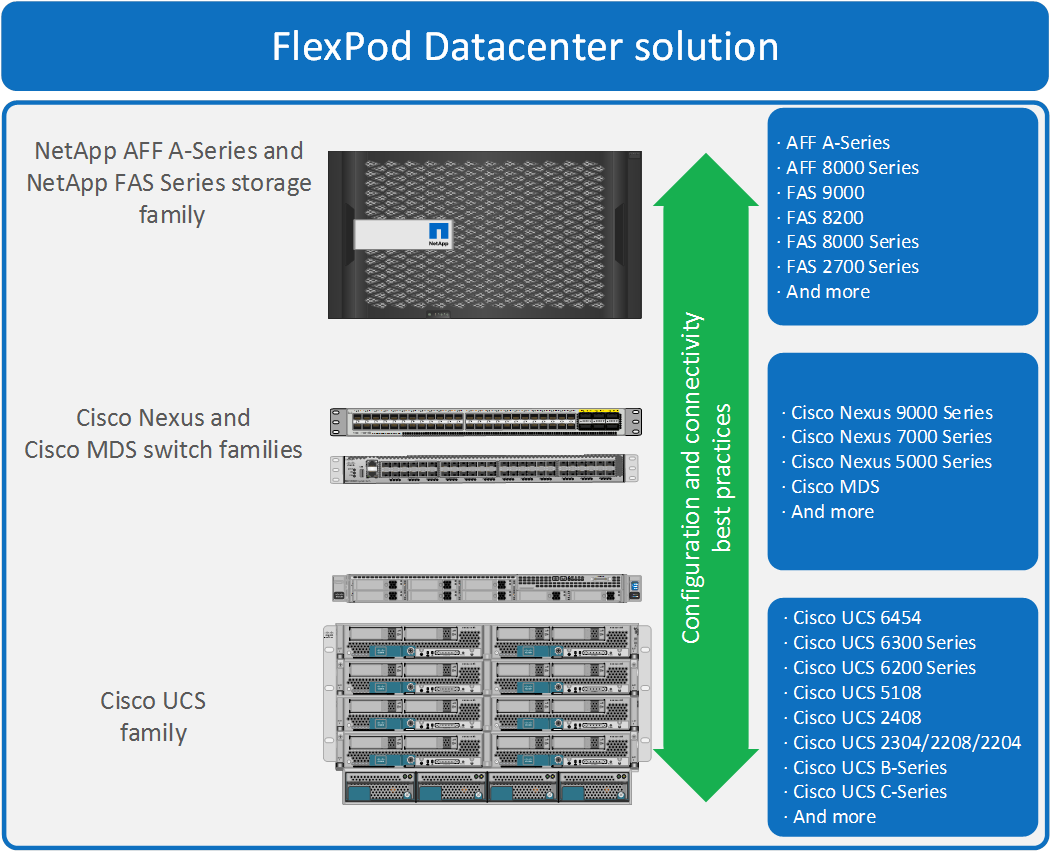
These components are connected and configured according to the best practices of both Cisco and NetApp to provide an ideal platform for running a variety of enterprise workloads with confidence. FlexPod can scale up for greater performance and capacity (adding compute, network, or storage resources individually as needed), or it can scale out for environments that require multiple consistent deployments (such as rolling out of additional FlexPod stacks). The reference architecture covered in this document leverages Cisco Nexus 9000 for the network switching element and pulls in the Cisco MDS 9000 for the SAN switching component.
One of the key benefits of FlexPod is its ability to maintain consistency during scale. Each of the component families shown (Cisco UCS, Cisco Nexus, and NetApp AFF) offers platform and resource options to scale the infrastructure up or down, while supporting the same features and functionality that are required under the configuration and connectivity best practices of FlexPod.
Cisco Nexus
Cisco Nexus series switches provide an Ethernet switching fabric for communications between the Cisco UCS, NetApp storage controllers, and the rest of a customer’s network. There are many factors to consider when choosing the main data switch in this type of architecture to support both the scale and the protocols required for the resulting applications. All Nexus switch models including the Nexus 5000 and Nexus 7000 are supported in this design and may provide additional features such as FCoE or OTV. However, be aware that there may be slight differences in setup and configuration based on the switch used. The validation for this deployment leverages the Cisco Nexus 9000 series switches, which deliver high performance 100/40GbE ports, density, low latency, and exceptional power efficiency in a broad range of compact form factors.
Many of the most recent single-site FlexPod designs also use this switch due to the advanced feature set and the ability to support Application Centric Infrastructure (ACI) mode. When leveraging ACI fabric mode, the Nexus 9000 series switches are deployed in a spine-leaf architecture. Although the reference architecture covered in this design does not leverage ACI, it lays the foundation for customer migration to ACI in the future, and fully supports ACI today if required.
For more information, refer to http://www.cisco.com/c/en/us/products/switches/nexus-9000-series-switches/index.html.
This FlexPod design deploys a single pair of Nexus 9336C-FX2 top-of-rack switches within each placement, using the traditional standalone mode running NX-OS.
The traditional deployment model delivers numerous benefits for this design:
· High performance and scalability with L2 and L3 support per port
· Layer 2 multipathing with all paths forwarding through the Virtual port-channel (vPC) technology
· VXLAN support at line rate
· Advanced reboot capabilities include hot and cold patching
· Hot-swappable power-supply units (PSUs) and fans with N+1 redundancy
Cisco Nexus 9000 provides an Ethernet switching fabric for communications between the Cisco UCS domain, the NetApp storage system and the enterprise network. In the FlexPod design, Cisco UCS Fabric Interconnects and NetApp storage systems are connected to the Cisco Nexus 9000 switches using virtual Port Channels (vPC)
Virtual Port Channel (vPC)
A virtual Port Channel (vPC) allows links that are physically connected to two different Cisco Nexus 9000 Series devices to appear as a single Port Channel. In a switching environment, the vPC provides the following benefits:
· Allows a single device to use a Port Channel across two upstream devices
· Eliminates Spanning Tree Protocol blocked ports and uses all available uplink bandwidth
· Provides a loop-free topology
· Provides fast convergence if either one of the physical links or a device fails
· Helps ensure high availability of the overall FlexPod system
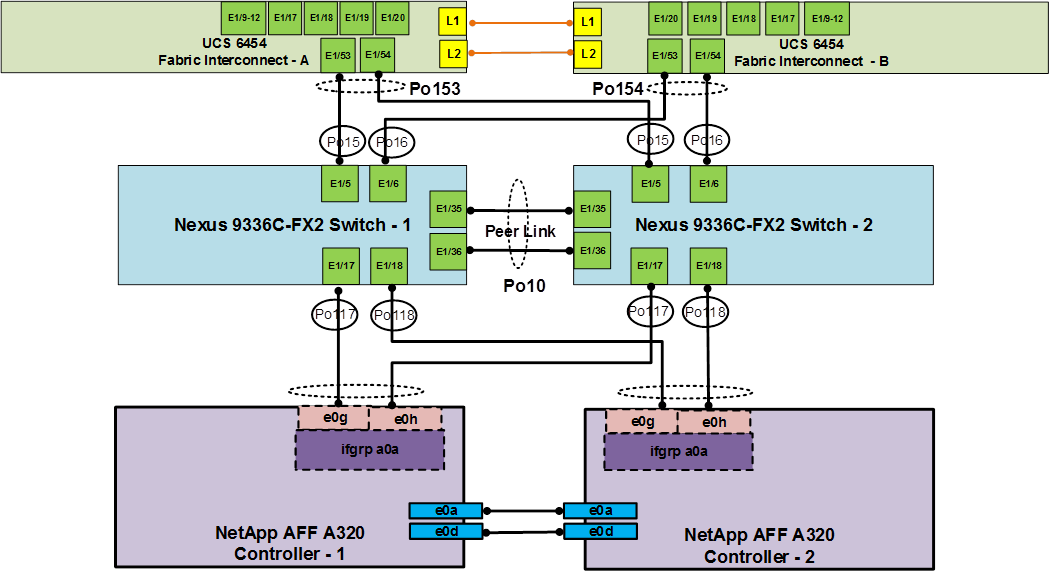
Figure 2 shows the connections between the Cisco Nexus 9000s, UCS Fabric Interconnects and NetApp AFF A320s. A vPC requires a “peer link” which is documented as port channel 10 in this diagram. In addition to the vPC peer-link, the vPC peer keepalive link is a required component of a vPC configuration. The peer keepalive link allows each vPC enabled switch to monitor the health of its peer. This link accelerates convergence and reduces the occurrence of split-brain scenarios. In this validated solution, the vPC peer keepalive link uses the out-of-band management network. This link is not shown in Figure 2.
Cisco Nexus 9000 Best Practices
Cisco Nexus 9000 related best practices used in the validation of the FlexPod architecture are summarized below:
Cisco Nexus 9000 Features Enabled
· Link Aggregation Control Protocol (LACP part of 802.3ad)
· Cisco Virtual Port Channeling (vPC) for link and device resiliency
· Cisco Discovery Protocol (CDP) for infrastructure visibility and troubleshooting
· Link Layer Discovery Protocol (LLDP) for additional infrastructure visibility and troubleshooting
vPC Considerations
· Define a unique domain ID
· Set the priority of the intended vPC primary switch lower than the secondary (default priority is 32768)
· Establish peer keepalive connectivity. It is recommended to use the out-of-band management network (mgmt0) or a dedicated switched virtual interface (SVI)
· Enable vPC auto-recovery feature
· Enable peer-gateway. Peer-gateway allows a vPC switch to act as the active gateway for packets that are addressed to the router MAC address of the vPC peer allowing vPC peers to forward traffic
· Enable IP ARP synchronization to optimize convergence across the vPC peer link.
· A minimum of two 10 Gigabit Ethernet connections are required for vPC
· All port channels should be configured in LACP active mode
Spanning Tree Considerations
· The spanning tree priority was not modified. Peer-switch (part of vPC configuration) is enabled which allows both switches to act as root for the VLANs
· Loopguard is disabled by default
· BPDU guard and filtering are enabled by default
· Bridge assurance is only enabled on the vPC Peer Link.
· Ports facing the NetApp storage controller and UCS are defined as “edge” trunk ports
For configuration details, refer to the Cisco Nexus 9000 Series Switches Configuration guides: http://www.cisco.com/c/en/us/support/switches/nexus-9000-series-switches/products-installation-and-configuration-guides-list.html.
NetApp AFF A320 Storage
With the new NetApp® AFF A-Series controller lineup, NetApp provides industry leading performance while continuing to provide a full suite of enterprise-grade data management and data protection features. AFF A-Series systems support end-to-end NVMe technologies, from NVMe-attached SSDs to front-end NVMe over Fibre Channel (NVMe/FC) host connectivity. These systems deliver the industry’s lowest latency for an enterprise all-flash array, making them a superior choice for driving the most demanding workloads and AI/DL applications. With a simple software upgrade to the modern NVMe/FC SAN infrastructure, you can drive more workloads with faster response times, without disruption or data migration.
This architecture uses the NetApp AFF A320 all-flash array as the foundation of the infrastructure storage. The A320 can be connected to NetApp NS224 2U storage shelves that have 24 NVMe SSD bays (that support 1.9TB, 3.8TB, 7.6TB and 15.3TB NVMe SSDs). The A320 comes with high bandwidth connectivity, such as 100/40/25GbE and 32/16Gb FC. It connects to the NVMe shelf through NVMe/RoCE protocol.
The AFF A320 system enables customers to:
· Accelerate traditional and emerging enterprise applications such as artificial intelligence and deep learning, analytics, and databases with extremely low latency.
· Reduce data center costs by consolidating applications with a powerful system.
· Future-proof their environment with NVMe technology, 100GbE Ethernet, and cloud integration.
NetApp also expanded its services to improve efficiency and performance while protecting against disruption and data loss.
NetApp’s expanded services portfolio now includes:
· SupportEdge Prestige offers a high-touch, concierge level of technical support that resolves issues faster through priority call routing. Customers are assigned a designated team of NetApp experts and receive specialized reporting, tools, and storage environment health assessments.
· Tiered Deployment Service accelerates time to value for new NetApp technology and reduces the risk of improper installation or misconfiguration. Three new high-quality options include Basic, Standard and Advanced Deployment, each aligned to customer business objectives.
· Managed Upgrade Service is a remotely delivered service that reduces security risks by ensuring NetApp software is always up to date with all security patches and firmware upgrades.
For more information about the NetApp AFF A-series controllers, see the AFF product page here: https://www.netapp.com/us/products/storage-systems/all-flash-array/aff-a-series.aspx.
You can view or download more technical specifications of the AFF A-series controllers here: https://www.netapp.com/us/media/ds-3582.pdf


NetApp ONTAP 9.6
NetApp ONTAP® 9.6 is the data management software that is used with the NetApp AFF A320 all-flash storage system in the solution design. ONTAP software offers unified storage for applications that read and write data over block or file-access protocol storage configurations. These storage configurations range from high-speed flash to lower-priced spinning media or cloud-based object storage.
ONTAP implementations can run on NetApp engineered FAS or AFF series arrays. They can run on commodity hardware (NetApp ONTAP Select), and in private, public, or hybrid clouds (NetApp Private Storage and NetApp Cloud Volumes ONTAP). Specialized implementations offer best-in-class converged infrastructure, featured here as part of the FlexPod® Datacenter solution or with access to third-party storage arrays (NetApp FlexArray® virtualization).
Together these implementations form the basic framework of the NetApp Data Fabric, with a common software-defined approach to data management, and fast efficient replication across systems. FlexPod and ONTAP architectures can serve as the foundation for both hybrid cloud and private cloud designs.
The following sections provide an overview of how ONTAP 9.6 is an industry-leading data management software architected on the principles of software defined storage.
Read more about all the capabilities of ONTAP data management software here: https://www.netapp.com/us/products/data-management-software/ontap.aspx
NetApp Storage Virtual Machine
A NetApp ONTAP cluster serves data through at least one, and possibly multiple, storage virtual machines (SVMs). An SVM is a logical abstraction that represents the set of physical resources of the cluster. Data volumes and network LIFs are created and assigned to an SVM and can reside on any node in the cluster to which that SVM has access. An SVM can own resources on multiple nodes concurrently, and those resources can be moved non-disruptively from one node in the storage cluster to another. For example, a NetApp FlexVol® flexible volume can be non-disruptively moved to a new node and aggregate, or a data LIF can be transparently reassigned to a different physical network port. The SVM abstracts the cluster hardware, and therefore it is not tied to any specific physical hardware.
An SVM can support multiple data protocols concurrently. Volumes within the SVM can be joined to form a single NAS namespace. The namespace makes all of the SVM's data available through a single share or mount point to NFS and CIFS clients. SVMs also support block-based protocols, and LUNs can be created and exported by using iSCSI, FC, FCoE. Any or all of these data protocols can be used within a given SVM. Storage administrators and management roles can be associated with an SVM, offering higher security and access control. This security is important in environments that have more than one SVM and when the storage is configured to provide services to different groups or sets of workloads.
Storage Efficiencies
Storage efficiency is a primary architectural design point of ONTAP data management software. A wide array of features enables you to store more data that uses less space. In addition to deduplication and compression, you can store your data more efficiently by using features such as unified storage, multitenancy, thin provisioning, and by using NetApp Snapshot™ technology.
Starting with ONTAP 9, NetApp guarantees that the use of NetApp storage efficiency technologies on AFF systems reduces the total logical capacity used to store customer data, up to a data reduction ratio of 7:1, based on the workload. This space reduction is enabled by a combination of several different technologies, including deduplication, compression, and compaction.
Compaction, which was introduced in ONTAP 9, is the latest patented storage efficiency technology released by NetApp. In the NetApp WAFL® file system, all I/O takes up 4KB of space, even if it does not actually require 4KB of data. Compaction combines multiple blocks that are not using their full 4KB of space together into one block. This one block can be more efficiently stored on the disk to save space. ONTAP 9.5 includes enhancements in how the compression and compaction algorithms in ONTAP work. The new storage efficiencies improve the ability of ONTAP to store more data in less space, reducing storage costs and maximizing the effective capacity of your storage system.
Encryption
Data security remains an important consideration for customers purchasing storage systems. Before ONTAP 9, NetApp supported full disk encryption in storage clusters. However, in ONTAP 9, the encryption capabilities of ONTAP are extended by adding an Onboard Key Manager (OKM). The OKM generates and stores keys for each of the drives in ONTAP, enabling ONTAP to provide all functionality required for encryption out of the box. Through this functionality, known as NetApp Storage Encryption (NSE), sensitive data stored on disk is secure and can only be accessed by ONTAP.
NetApp has extended the encryption capabilities further with NetApp Volume Encryption (NVE), a software-based mechanism for encrypting data. It allows a user to encrypt data at the per-volume level instead of requiring encryption of all data in the cluster, providing more flexibility and granularity to ONTAP administrators. This encryption extends to Snapshot copies and NetApp FlexClone volumes that are created in the cluster. One benefit of NVE is that it runs after the implementation of the storage efficiency features, and, therefore, it does not interfere with the ability of ONTAP to create space savings. New in ONTAP 9.5 is the ability to preserve NVE in NetApp Cloud Volumes. NVE unifies the data encryption capabilities available on-premises and extends them into the cloud. NVE in ONTAP 9.5 is also FIPS 140-2 compliant. This compliance helps businesses adhere to federal regulatory guidelines for data at rest in the cloud.
For more information about encryption in ONTAP, see the NetApp Power Encryption Guide in the NetApp ONTAP 9 Documentation Center.
FlexClone
NetApp FlexClone technology enables instantaneous point-in-time copies of a FlexVol volume without consuming any additional storage until the cloned data changes from the original. FlexClone volumes add extra agility and efficiency to storage operations. They take only a few seconds to create and do not interrupt access to the parent FlexVol volume. FlexClone volumes use space efficiently, applying the ONTAP architecture to store only data that changes between the parent and clone. FlexClone volumes are suitable for testing or development environments, or any environment where progress is made by locking-in incremental improvements. FlexClone volumes also benefit any business process where you must distribute data in a changeable form without endangering the integrity of the original.
SnapMirror (Data Replication)
NetApp SnapMirror® is an asynchronous replication technology for data replication across different sites, within the same data center, on-premises datacenter to cloud, or cloud to on-premises datacenter. ONTAP 9.5 introduces volume granular, zero data loss protection with SnapMirror Synchronous (SM-S). SnapMirror Synchronous extends traditional SnapMirror volume replication to synchronous mode meeting zero recovery point objective (RPO) disaster recovery and compliance objectives. Policy-based replication provides a simple and familiar configuration interface that is managed with the same tools as traditional SnapMirror including ONTAP CLI, NetApp OnCommand System Manager, NetApp OnCommand Unified Manager, and NetApp Manageability SDK.
Virtual Storage Console
NetApp Virtual Storage Console (VSC) for VMware vSphere is a vSphere client plug-in that provides end-to-end lifecycle management for virtual machines (VMs) in VMware environments that use NetApp storage systems. VSC provides visibility into the NetApp storage environment from within the vSphere web client. VMware administrators can easily perform tasks that improve both server and storage efficiency while still using role-based access control to define the operations that administrators can perform.
VSC applies NetApp technologies to deliver comprehensive, centralized management of NetApp storage operations in both SAN and NAS-based VMware infrastructures. These operations include discovery, health and capacity monitoring, and datastore provisioning. VSC results in tighter integration between storage and virtual environments and greatly simplifies virtualized storage management. After it is installed, VSC provides a view of the storage environment from a VMware administrator’s perspective and optimizes storage and host configurations for use with NetApp FAS and AFF storage.
VMware vSphere Virtual Volumes with ONTAP
VVols are the actual virtual machine files and disks stored in the VVol datastore. The Virtual Volume datastore or container is the logical construct that stores the VVols in vCenter. ONTAP supports multiple FlexVol volumes in a single Virtual Volume datastore, and the datastore can span multiple nodes in an ONTAP cluster, combining flash and hybrid systems with different capabilities. They are provisioned by selecting a host or cluster in vCenter and then selecting Provision VVol Datastore from the VSC.
The virtual appliance for Virtual Storage Console (VSC), VASA Provider, and Storage Replication Adapter (SRA) for VMware vSphere is the only software tool required to begin using VVols with ONTAP.
Storage policy-based management can be achieved in VVols with VASA (VMware vSphere APIs for Storage Awareness). The storage administrator can define a range of storage capabilities, which the VM administrator can then use to provision VMs with a storage policy that identifies its requirements. The mapping between the VM storage policy and the datastore storage capability profile allows vCenter to display a list of compatible datastores for selection.
The following are the benefits of using VVols in ONTAP:
· Policy-Based Management
· VM Granular Management on SAN
· Greater Storage Offload Capabilities
Here are the common use cases for VVol storage:
· On-demand provisioning of temporary VMs (labs, training). In this case, customers use VVols with additional automation software to rapidly deploy new VMs for temporary usage in training or other labs, based on clones of existing VMs or VMDKs. Offloading clones to ONTAP is near instantaneous whether within a single volume or cross-volume.
· On-demand provisioning of long-term VMs (private cloud with vRealize or OpenStack automation). As with the previous use case, clones are quickly created within a single volume, or across multiple volumes in an aggregate. They are also storage efficient. Clones within a volume use ONTAP file clones, which are like NetApp FlexClone® volumes and only store changes from the source VVol file or LUN. Clone copies across volumes are not instantly storage efficient, but they benefit from background volume and aggregate deduplication on AFF systems. Therefore, long-term VMs for production or other application purposes are created quickly, take minimal space, and can benefit from VM-level protection (using VMware snapshots or VADP backup) and performance management (with ONTAP QoS).
NetApp SnapCenter
NetApp SnapCenter® is a NetApp next-generation data protection software for tier 1 enterprise applications. SnapCenter Software is a simple, centralized, scalable platform that provides application-consistent data protection for applications, databases, host file systems, and VMs running on ONTAP systems anywhere in the Hybrid Cloud.
SnapCenter leverages NetApp Snapshot, SnapRestore, FlexClone, SnapMirror, and SnapVault technologies to provide the following:
· Fast, space-efficient, application-consistent, disk-based backups
· Rapid, granular restore and application-consistent recovery
· Quick, space-efficient cloning
SnapCenter enables to integrate seamlessly with those offered by Oracle, Microsoft, SAP, VMware, and MongoDB across FC, iSCSI, and NAS protocols. This integration enables IT organizations to scale their storage infrastructure, meet increasingly stringent SLA commitments, and improve the productivity of administrators across the enterprise. SnapCenter is used in this solution for backup and restore of VMware virtual machines.
SnapCenter Architecture
The SnapCenter platform is based on a multitiered architecture that includes a centralized management server (SnapCenter Server) and a SnapCenter plug-in host.
Figure 4 illustrates the high-level architecture of the NetApp SnapCenter Server.
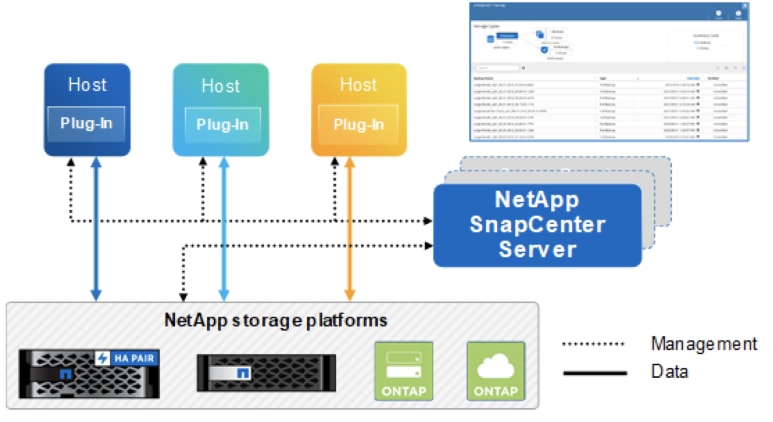
The SnapCenter Server includes a web server, a centralized HTML5-based user interface, PowerShell cmdlets, REST APIs, and the SnapCenter repository.
SnapCenter enables load balancing, high availability, and horizontal scaling across multiple SnapCenter Servers within a single user interface. You can accomplish high availability by using Network Load Balancing (NLB) and Application Request Routing (ARR) with SnapCenter. For larger environments with thousands of hosts, adding multiple SnapCenter Servers can help balance the load.
The SnapCenter Server can push out plug-ins to remote hosts. These plug-ins are used to interact with an application, a database, or a file system. The SnapCenter Server and plug-ins communicate with the host agent using HTTPS. Usually, the plug-ins must be present on the remote host so that application-level or database-level commands can be issued from the same host where the application or database is running.
To manage the plug-ins and the interaction between the SnapCenter Server and the plug-in host, SnapCenter uses SM Service. SM service is a NetApp SnapManager® web service running on top of Windows Server internet information services (IIS) on the SnapCenter Server. SM Service takes all client requests such as backup, restore, and clone.
The SnapCenter Server communicates those requests to SMCore, which is a service that runs co-located within the SnapCenter Server and remote servers. SMCore plays a significant role in coordinating with the SnapCenter plug-ins package for Windows.
For SnapCenter 4.2 and later, the SnapCenter Plug-in for VMware vSphere is deployed as part of the NetApp Data Broker virtual appliance Linux-based VM. It provides a vSphere web client GUI on vCenter to protect VMware virtual machines (VMs) and datastores and supports SnapCenter application-specific plug-ins in protecting virtualized databases on primary and secondary storage.
SnapCenter Plug-in for VMware vSphere Features
The SnapCenter Plug-in for VMware vSphere features provided by the virtual appliance include the following:
· Support for VMs, VMDKs, and datastores
- The plug-in provides a VMware vSphere web client in vCenter. You use the web client GUI to perform VM-consistent backups of VMs, VMDKs, and datastores. You can also restore VMs and VMDKs and restore files and folders that reside on a guest OS.
![]() When backing up VMs, VMDKs, and datastores, the plug-in does not support RDMs. Backup jobs for VMs ignore RDMs. If you need to back up RDMs, you must use a SnapCenter application-based plug-in.
When backing up VMs, VMDKs, and datastores, the plug-in does not support RDMs. Backup jobs for VMs ignore RDMs. If you need to back up RDMs, you must use a SnapCenter application-based plug-in.
![]() VVOl datastores are not supported.
VVOl datastores are not supported.
- The plug-in also provides a MySQL database on the virtual appliance VM that contains SnapCenter Plug-in for VMware vSphere metadata.
· Support for virtualized databases
- The plug-in supports backup, recovery, and cloning of virtualized applications and file systems (for example, virtualized SQL, Oracle, and Exchange databases) when you have the appropriate application-based SnapCenter plug-ins installed and you are using SnapCenter to perform data protection operations. Data protection operations are managed using the SnapCenter GUI. SnapCenter natively leverages the SnapCenter Plug-in for VMware vSphere for all data protection operations on VMDKs, raw device mappings (RDMs), and NFS datastores. After the virtual appliance is deployed, the plug- in handles all interactions with vCenter. The plug-in supports all SnapCenter application- based plug-ins.
![]() SnapCenter does not support single Snapshot copies of databases and VMs together. Backups for VMs and databases must be scheduled and run independently, which creates separate Snapshot copies, even if the databases and VMs are hosted in the same volume. Database application backups must be scheduled by using the SnapCenter GUI; VM and datastore backups must be scheduled by using the SnapCenter vSphere web client GUI.
SnapCenter does not support single Snapshot copies of databases and VMs together. Backups for VMs and databases must be scheduled and run independently, which creates separate Snapshot copies, even if the databases and VMs are hosted in the same volume. Database application backups must be scheduled by using the SnapCenter GUI; VM and datastore backups must be scheduled by using the SnapCenter vSphere web client GUI.
· VMware Tools is required for VM consistent Snapshot copies
- If VMware Tools is not installed and running, the file system is not quiesced and a crash- consistent Snapshot is created.
· VMware Storage vMotion is required for restore operations in SAN (VMFS) environments
- The restore workflow for VMware file system (VMFS) utilizes the VMware Storage vMotion feature. Storage vMotion is a part of the vSphere Standard License but is not available with the vSphere Essentials or Essentials Plus licenses.
- Most restore operations in NFS environments use native ONTAP functionality (for example, Single File SnapRestore) and do not require VMware Storage vMotion.
· The virtual appliance is deployed as a Linux VM.
- Although the virtual appliance must be installed as a Linux VM, the SnapCenter Plug-in for VMware vSphere supports both Windows-based and Linux-based vCenter. SnapCenter natively uses this plug-in without user intervention to communicate with your vCenter to support SnapCenter application-based plug-ins that perform data protection operations on Windows and Linux virtualized applications.
· Backup jobs for VMs and datastores must be migrated to the SnapCenter Plug-in for VMware vSphere
In addition to these major features, the SnapCenter Plug-in for VMware vSphere also provides support for iSCSI, Fibre Channel, FCoE, VMDK over NFS 3.0 and 4.1, and VMDK over VMFS 5.0 and 6.0. For the latest information about supported versions, see the NetApp Interoperability Matrix Tool (IMT). For information about NFS protocols and ESXi, see the VMware "vSphere Storage" documentation. For information about SnapCenter data protection, see the Data Protection Guide for your SnapCenter plug-in in the SnapCenter Documentation Center. For information about deploying the virtual appliance for SnapCenter Plug-in for VMware vSphere, see the NetApp Data Broker Deployment Guide for SnapCenter Plug-in for VMware vSphere.
Active IQ Unified Manager
NetApp® Active IQ® Unified Manager is a graphical management product that provides comprehensive monitoring and key management capabilities for NetApp ONTAP® systems to help manage the availability, capacity, protection, and performance risks of your storage systems. You can deploy Unified Manager on a Linux server, on a Windows server, or as a virtual appliance on a VMware host.
Unified Manager enables to monitor your clusters. When issues occur in the cluster, Unified Manager notifies you about the details of such issues through events. Some events also provide you with a remedial action that you can take to rectify the issues. You can configure alerts for events so that when issues occur, you are notified through email, and SNMP traps.
Unified Manager enables to manage storage objects in your environment by associating them with annotations. You can create custom annotations and dynamically associate clusters, storage virtual machines (SVMs), and volumes with the annotations through rules.
Unified Manager enables Reporting different views of your network, providing actionable intelligence on capacity, health, performance, and protection data. You can customize your views by showing and hiding columns, rearranging columns, filtering data, sorting data, and searching the results. You can save custom views for reuse, download them as reports, and schedule them as recurring reports to distribute through email.
Unified Manager enables to plan the storage requirements of your cluster objects using the information provided in the capacity and health charts, for the respective cluster object.
Cisco Unified Computing System
Cisco UCS 6454 Fabric Interconnects
The Cisco UCS Fabric Interconnects provide a single point for connectivity and management for the entire system. Typically deployed as an active-active pair, the system’s fabric interconnects integrate all components into a single, highly available management domain controlled by Cisco UCS Manager. The fabric interconnects manage all I/O efficiently and securely at a single point, resulting in deterministic I/O latency regardless of a server or virtual machine’s topological location in the system.
The Cisco UCS Fabric Interconnect provides both network connectivity and management capabilities for the Cisco UCS system. IOM modules in the blade chassis support power supply, along with fan and blade management. They also support port channeling and, thus, better use of bandwidth. The IOMs support virtualization-aware networking in conjunction with the Fabric Interconnects and Cisco Virtual Interface Cards (VIC).
The Cisco UCS 6454 Fabric Interconnect is a core part of the Cisco Unified Computing System, providing both network connectivity and management capabilities for the system. The Cisco UCS 6454 offers line-rate, low-latency, lossless 10/25/40/100 Gigabit Ethernet, Fibre Channel over Ethernet (FCoE), and 32 Gigabit Fibre Channel functions.
The Cisco UCS 6454 54-Port Fabric Interconnect is a One-Rack-Unit (1RU) 10/25/40/100 Gigabit Ethernet, FCoE and Fibre Channel switch offering up to 3.82 Tbps throughput and up to 54 ports. The switch has 28 10/25-Gbps Ethernet ports, 4 1/10/25-Gbps Ethernet ports, 6 40/100-Gbps Ethernet uplink ports and 16 unified ports that can support 10/25-Gbps Ethernet ports or 8/16/32-Gbps Fibre Channel ports. All Ethernet ports are capable of supporting FCoE.
Cisco UCS 2408 Fabric Extender
The Cisco UCS 2408 connects the I/O fabric between the Cisco UCS 6454 Fabric Interconnect and the Cisco UCS 5100 Series Blade Server Chassis, enabling a lossless and deterministic converged fabric to connect all blades and chassis together. Because the fabric extender is similar to a distributed line card, it does not perform any switching and is managed as an extension of the fabric interconnects. This approach removes switching from the chassis, reducing overall infrastructure complexity and enabling Cisco UCS to scale to many chassis without multiplying the number of switches needed, reducing TCO, and allowing all chassis to be managed as a single, highly available management domain.
The Cisco UCS 2408 Fabric Extender has eight 25-Gigabit Ethernet, FCoE-capable, Small Form-Factor Pluggable (SFP28) ports that connect the blade chassis to the fabric interconnect. Each Cisco UCS 2408 provides 10-Gigabit Ethernet ports connected through the midplane to each half-width slot in the chassis, giving it a total 32 10G interfaces to UCS blades. Typically configured in pairs for redundancy, two fabric extenders provide up to 400 Gbps of I/O from FI 6454's to 5108 chassis.
Cisco UCS 1400 Series Virtual Interface Cards (VICs)
Cisco VICs support Cisco SingleConnect technology, which provides an easy, intelligent, and efficient way to connect and manage computing in your data center. Cisco SingleConnect unifies LAN, SAN, and systems management into one simplified link for rack servers and blade servers. This technology reduces the number of network adapters, cables, and switches needed and radically simplifies the network, reducing complexity. Cisco VICs can support 256 Express (PCIe) virtual devices, either virtual Network Interface Cards (vNICs) or virtual Host Bus Adapters (vHBAs), with a high rate of I/O Operations Per Second (IOPS), support for lossless Ethernet, and 10/25/40/100-Gbps connection to servers. The PCIe Generation 3 x16 interface helps ensure optimal bandwidth to the host for network-intensive applications, with a redundant path to the fabric interconnect. Cisco VICs support NIC teaming with fabric failover for increased reliability and availability. In addition, it provides a policy-based, stateless, agile server infrastructure for your data center.
The Cisco VIC 1400 series is designed exclusively for the M5 generation of Cisco UCS B-Series Blade Servers and Cisco UCS C-Series Rack Servers. The adapters are capable of supporting 10/25/40/100-Gigabit Ethernet and Fibre Channel over Ethernet (FCoE). It incorporates Cisco’s next-generation Converged Network Adapter (CNA) technology and offers a comprehensive feature set, providing investment protection for future feature software releases.
Cisco UCS Differentiators
Cisco’s Unified Computing System is revolutionizing the way servers are managed in the datacenter. The following are the unique differentiators of Cisco Unified Computing System and Cisco UCS Manager.
· Embedded Management — In Cisco UCS, the servers are managed by the embedded firmware in the Fabric Interconnects, eliminating need for any external physical or virtual devices to manage the servers.
· Unified Fabric — In Cisco UCS, from blade server chassis or rack servers to FI, there is a single Ethernet cable used for LAN, SAN and management traffic. This converged I/O results in reduced cables, SFPs and adapters – reducing capital and operational expenses of the overall solution.
· Auto Discovery — By simply inserting the blade server in the chassis or connecting the rack server to the fabric interconnect, discovery and inventory of compute resources occurs automatically without any management intervention. The combination of unified fabric and auto-discovery enables the wire-once architecture of Cisco UCS, where compute capability of Cisco UCS can be extended easily while keeping the existing external connectivity to LAN, SAN and management networks.
· Policy Based Resource Classification — Once a compute resource is discovered by Cisco UCS Manager, it can be automatically classified to a given resource pool based on policies defined. This capability is useful in multi-tenant cloud computing. This CVD showcases the policy-based resource classification of Cisco UCS Manager.
· Combined Rack and Blade Server Management — Cisco UCS Manager can manage Cisco UCS B-series blade servers and Cisco UCS C-series rack servers under the same Cisco UCS domain. This feature, along with stateless computing makes compute resources truly hardware form factor agnostic.
· Model based Management Architecture — The Cisco UCS Manager architecture and management database is model based, and data driven. An open XML API is provided to operate on the management model. This enables easy and scalable integration of Cisco UCS Manager with other management systems.
· Policies, Pools, Templates — The management approach in Cisco UCS Manager is based on defining policies, pools and templates, instead of cluttered configuration, which enables a simple, loosely coupled, data driven approach in managing compute, network and storage resources.
· Loose Referential Integrity — In Cisco UCS Manager, a service profile, port profile or policies can refer to other policies or logical resources with loose referential integrity. A referred policy cannot exist at the time of authoring the referring policy or a referred policy can be deleted even though other policies are referring to it. This provides different subject matter experts to work independently from each-other. This provides great flexibility where different experts from different domains, such as network, storage, security, server and virtualization work together to accomplish a complex task.
· Policy Resolution — In Cisco UCS Manager, a tree structure of organizational unit hierarchy can be created that mimics the real-life tenants and/or organization relationships. Various policies, pools and templates can be defined at different levels of organization hierarchy. A policy referring to another policy by name is resolved in the organizational hierarchy with closest policy match. If no policy with specific name is found in the hierarchy of the root organization, then the special policy named “default” is searched. This policy resolution practice enables automation friendly management APIs and provides great flexibility to owners of different organizations.
· Service Profiles and Stateless Computing — A service profile is a logical representation of a server, carrying its various identities and policies. This logical server can be assigned to any physical compute resource as far as it meets the resource requirements. Stateless computing enables procurement of a server within minutes, which used to take days in legacy server management systems.
· Built-in Multi-Tenancy Support — The combination of policies, pools and templates, loose referential integrity, policy resolution in the organizational hierarchy and a service profiles-based approach to compute resources makes Cisco UCS Manager inherently friendly to multi-tenant environments typically observed in private and public clouds.
· Extended Memory — The enterprise-class Cisco UCS B200 M5 blade server extends the capabilities of Cisco’s Unified Computing System portfolio in a half-width blade form factor. The Cisco UCS B200 M5 harnesses the power of the latest Intel® Xeon® Scalable Series processor family CPUs with up to 3 TB of RAM (using 128 GB DIMMs) – allowing huge VM to physical server ratios required in many deployments or allowing large memory operations required by certain architectures like big data.
· Simplified QoS — Even though Fibre Channel and Ethernet are converged in the Cisco UCS fabric, built-in support for QoS and lossless Ethernet makes it seamless. Network Quality of Service (QoS) is simplified in Cisco UCS Manager by representing all system classes in one GUI panel.
Cisco UCS B200 M5 Blade Servers
The Cisco UCS B200 M5 server shown in Figure 5, is a half-width blade upgrade from the Cisco UCS B200 M4.
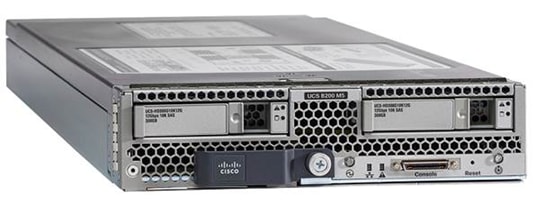
It features:
· 2nd Gen Intel® Xeon® Scalable and Intel® Xeon® Scalable processors with up to 28 cores per socket
· Up to two GPUs
· Two Small-Form-Factor (SFF) drive slots
· Up to two Secure Digital (SD) cards or M.2 SATA drives
· Up to 40 Gbps of I/O throughput with Cisco UCS 6454 FI
For more information about the Cisco UCS B200 M5 Blade Servers, see: http://www.cisco.com/c/en/us/products/collateral/servers-unified-computing/ucs-b-series-blade-servers/datasheet-c78-739296.html.
Cisco UCS C220 M5 Rack Servers
The Cisco UCS C220 M5 rack server shown in Figure 6, is a high-density 2-socket rack server that is an upgrade from the Cisco UCS C220 M4.

It features:
· 2nd Gen Intel® Xeon® Scalable and Intel® Xeon® Scalable processors, 2-socket
· Up to 24 DDR4 DIMMs for improved performance with up to 12 DIMM slots ready for Intel Optane™ DC Persistent Memory
· Up to 10 Small-Form-Factor (SFF) 2.5-inch drives or 4 Large-Form-Factor (LFF) 3.5-inch drives (77 TB storage capacity with all NVMe PCIe SSDs)
· Support for 12-Gbps SAS modular RAID controller in a dedicated slot, leaving the remaining PCIe Generation 3.0 slots available for other expansion cards
· Modular LAN-On-Motherboard (mLOM) slot that can be used to install a Cisco UCS Virtual Interface Card (VIC) without consuming a PCIe slot
· Dual embedded Intel x550 10GBASE-T LAN-On-Motherboard (LOM) ports
· Up to 100 Gbps of I/O throughput with Cisco UCS 6454 FI
For more information about the Cisco UCS B200 M5 Blade Servers, see: https://www.cisco.com/c/en/us/products/collateral/servers-unified-computing/ucs-c-series-rack-servers/datasheet-c78-739281.html.
Cisco Intersight
Cisco Intersight is a Software-as-a-Service (SaaS) infrastructure management platform that is augmented by other intelligent systems. It provides global management of the Cisco Unified Computing System™ (Cisco UCS) infrastructure anywhere. Intersight provides a holistic approach to managing distributed computing environments from the core to the edge. The Cisco Intersight virtual appliance (available in the Essentials edition) provides customers with deployment options while still offering all the benefits of SaaS. This deployment flexibility enables organizations to achieve a higher level of automation, simplicity, and operational efficiency.
Cisco UCS systems are fully programmable infrastructures. Cisco Intersight includes a RESTful API to provide full programmability and deep integrations with third-party tools and systems. The platform and the connected systems are DevOps-enabled to facilitate continuous delivery. Customers have come to appreciate the many benefits of SaaS infrastructure management solutions. Cisco Intersight monitors the health and relationships of all the physical and virtual infrastructure components. Telemetry and configuration information is collected and stored in accordance with Cisco’s information security requirements. The data is isolated and displayed through an intuitive user interface. The virtual appliance feature enables users to specify what data is sent back to Cisco with a single point of egress from the customer network.
This cloud-powered intelligence can assist organizations of all sizes. Because the Cisco Intersight software gathers data from the connected systems, it learns from hundreds of thousands of devices in diverse customer environments. This data is combined with Cisco best-practices to enable Cisco Intersight to evolve and become smarter. As the Cisco Intersight knowledge base increases, trends are revealed, and information and insights are provided through the recommendation engine.
Cisco MDS
The Cisco® MDS 9132T 32G Multilayer Fabric Switch is the next generation of the highly reliable, flexible, and low-cost Cisco MDS 9100 Series switches. It combines high performance with exceptional flexibility and cost effectiveness. This powerful, compact one rack-unit (1RU) switch scales from 8 to 32 line-rate 32 Gbps Fibre Channel ports. The Cisco MDS 9132T delivers advanced storage networking features and functions with ease of management and compatibility with the entire Cisco MDS 9000 Family portfolio for reliable end-to-end connectivity. This switch also offers state-of-the-art SAN analytics and telemetry capabilities that have been built into this next-generation hardware platform. This new state-of-the-art technology couples the next-generation port ASIC with a fully dedicated Network Processing Unit designed to complete analytics calculations in real time. The telemetry data extracted from the inspection of the frame headers are calculated on board (within the switch) and, using an industry-leading open format, can be streamed to any analytics-visualization platform. This switch also includes a dedicated 10/100/1000BASE-T telemetry port to maximize data delivery to any telemetry receiver including Cisco Data Center Network Manager.
For more information about the MDS 9132T, review the product data sheet: https://www.cisco.com/c/en/us/products/collateral/storage-networking/mds-9100-series-multilayer-fabric-switches/datasheet-c78-739613.html.
MDS Insertion into FlexPod
The MDS 9132T is inserted into the FlexPod design to provide 32 Gbps Fibre Channel switching between the NetApp AFF A800 storage controllers, and Cisco UCS Managed B-Series and C-Series servers connected to the Cisco UCS 6454 Fabric Interconnects. Adding the MDS to the FlexPod infrastructure allows for:
· Increased scaling of both the NetApp storage and the Cisco UCS compute resources
· Large range of existing models supported from the 9100, 9200, 9300, and 9700 product lines
· A dedicated network for fibre channel storage traffic
· Increased tenant separation
· Deployments utilizing existing qualified SAN switches that might be within the customer environment
Smart Zoning with MDS
Configuration of the Cisco MDS within this FlexPod design takes advantage of Smart Zoning to increase zoning and administration efficiency within the MDS. Smart Zoning allows for reduced TCAM (ternary content addressable memory) entries, which are fabric ACL entries of the MDS allowing traffic between targets and initiators. When calculating TCAMs used, two TCAM entries will be created for each connection of devices within the zone. Without Smart Zoning enabled for a zone, all targets will have a pair of TCAMs established between each other, and all initiators will additionally have a pair of TCAMs established to other initiators in the zone. In other words, all targets are zoned to all targets and all initiators are zoned to all initiators in addition to the desired all initiators being zoned to all targets.
Using Smart Zoning, Targets and Initiators are identified, reducing TCAMs needed to only target to initiator within the zone.
Within the traditional zoning model for a multiple initiator, multiple target zone, the TCAM entries will grow rapidly, representing a relationship of TCAMs = (T+I)*(T+I)-1) where T = targets and I = initiators. For Smart Zoning configuration, this same multiple initiator, multiple target zone will instead have TCAMs = 2*T*I where T = targets and I = initiators.
With Smart Zoning, zones can now be defined as one-to-many, many-to-one, or many-to-many without incurring a penalty in switch resource consumption. Thus, administrators can now define zones to correspond to entities that actually are meaningful in their data center operations. For example, they can define a zone for an application, or for an application cluster, or for a hypervisor cluster without compromising internal resource utilization. It is recommended in FlexPod to configure zones corresponding to NetApp Storage Virtual Machines (SVMs). In this configuration, the one zone for each SVM contains the Fibre Channel Logical Interface (LIF) targets for that fabric defined in the SVM, and the initiator worldwide node names (WWNNs) for that fabric for all Cisco UCS servers that need to access the SVM storage. Later, if any servers are added, the initiator WWNNs can then simply be added to the appropriate zones. This saves significant administrative effort over defining a separate zone for each UCS server and adding the redundant targets used by other UCS servers.
For more information about Smart Zoning, see: https://www.cisco.com/c/dam/en/us/products/collateral/storage-networking/mds-9100-series-multilayer-fabric-switches/at_a_glance_c45-708533.pdf.
VMware vSphere 6.7 Update 2
VMware vSphere is a virtualization platform for holistically managing large collections of infrastructure (resources-CPUs, storage and networking) as a seamless, versatile, and dynamic operating environment. Unlike traditional operating systems that manage an individual machine, VMware vSphere aggregates the infrastructure of an entire data center to create a single powerhouse with resources that can be allocated quickly and dynamically to any application in need.
vSphere 6.7 Update 2 brings a number of improvements including, but not limited to:
· vSphere Web Client and fully featured HTML-5 client
· Introducing Network File System (NFS) and Samba (SMB) as the newest protocols for vCenter File-Based Backup and Restore of the vCenter Server Appliance.
· vSphere Health Categories and Alarms
· Content Library Improvements
A VMware design change in this solution is to now recommend three VMware ESXi hosts for the VMware management cluster. According to Architecting a vSphere Compute Platform, “The minimum size of a cluster is two nodes for vSphere HA to protect workloads in case one host stops functioning. However, in most use cases, a 3-node cluster is far more appropriate because you have the option of running maintenance tasks on an ESXi server without having to disable HA.”
For more information about VMware vSphere and its components, see: http://www.vmware.com/products/vsphere.html.
Physical Topology
Figure 7 shows the VMware vSphere built on FlexPod components and the network connections for a configuration with the Cisco UCS 6454 Fabric Interconnects. This design has port-channeled 10 Gb Ethernet connections between the Cisco UCS 5108 Blade Chassis and the Cisco UCS Fabric Interconnects, port-channeled 25 Gb Ethernet connections between the Cisco UCS C-Series rack-mounted servers and the Cisco UCS Fabric Interconnects, and 100 Gb Ethernet connections between the Cisco UCS Fabric Interconnect and Cisco Nexus 9000s, and between Cisco Nexus 9000s and NetApp AFF A800 storage array.
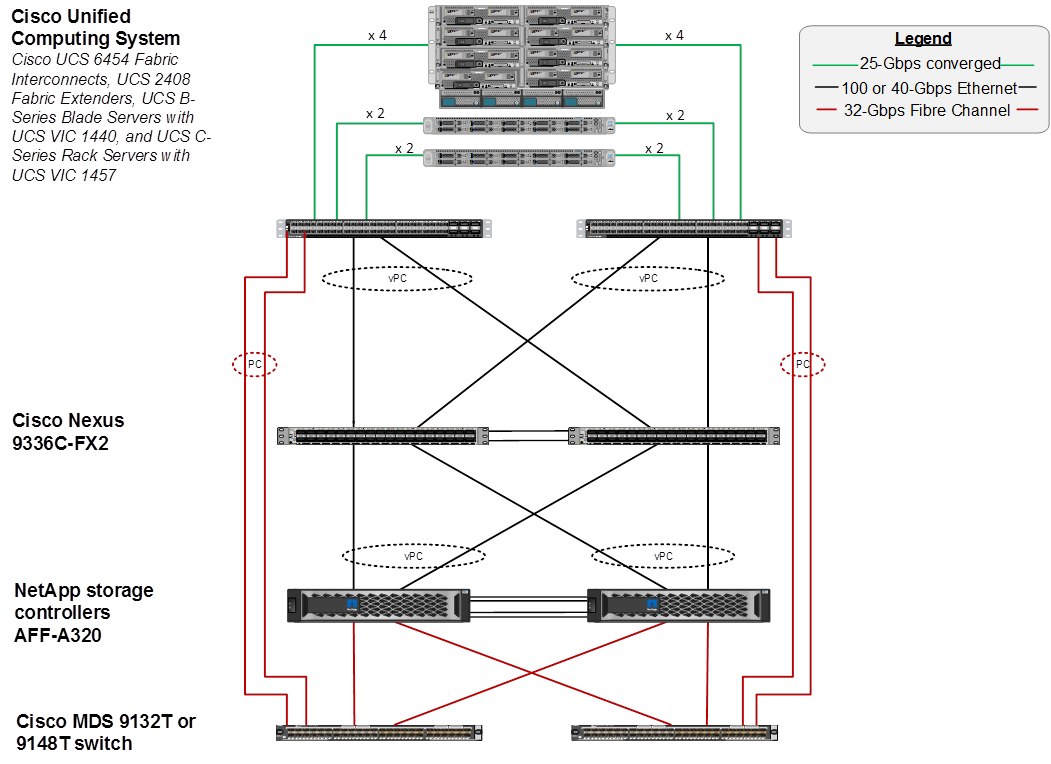
This infrastructure option expanded with Cisco MDS switches sitting between the Cisco UCS Fabric Interconnect and the NetApp AFF A320 to provide FC-booted hosts with 32 Gb FC block-level access to shared storage. The reference architecture reinforces the "wire-once" strategy, because as additional storage is added to the architecture, no re-cabling is required from the hosts to the Cisco UCS fabric interconnect.
The reference 100Gb based hardware configuration includes:
· Two Cisco Nexus 9336C-FX2 switches
· Two Cisco UCS 6454 fabric interconnects with Cisco UCS 2408 fabric extenders
· Two Cisco MDS 9132T multilayer fabric switches
· One NetApp AFF A320 (HA pair) running ONTAP 9.6 with NVMe SSD disk shelves
Considerations
SAN Boot
NetApp recommends implementing SAN boot for Cisco UCS Servers in the FlexPod Datacenter solution. Implementing SAN boot enables the operating system to be safely secured by the NetApp AFF storage system, providing better performance. In this design, both iSCSI and Fibre Channel SAN boot are validated.
In iSCSI SAN boot, each Cisco UCS Server is assigned two iSCSI vNICs (one for each SAN fabric) that provide redundant connectivity all the way to the storage. The 100Gb Ethernet storage ports, in this example e5a and e5b, which are connected to the Nexus switches are grouped to form one logical port called an interface group (ifgroup) (in this example, a0a). The iSCSI virtual LANs (VLANs) are created on the ifgroup and the iSCSI LIFs are created on the iSCSI VLAN ports (in this example, a0a-<iSCSI-A-VLAN>). The iSCSI boot LUN is exposed to the servers through the iSCSI LIF by using igroups. This feature enables only the authorized server to have access to the boot LUN. See Figure 8 for the port and LIF layout.

In the Fibre Channel SAN boot architecture, each Cisco UCS Server boots by connecting the NetApp AFF storage to the Cisco MDS switch. The 32Gb FC storage ports, in this example 2a and 2b, are connected to the Cisco MDS switch. The FC LIFs are created on the physical ports and each FC LIF is uniquely identified by its target WWPN. The storage system target WWPNs can be zoned with the server initiator WWPNs in the Cisco MDS switches. The FC boot LUN is exposed to the servers through the FC LIF by using the MDS switch. This feature enables only the authorized server to have access to the boot LUN. See Figure 9 for the port and LIF layout.

Unlike NAS network interfaces, the SAN network interfaces are not configured to fail over during a failure. Instead if a network interface becomes unavailable, the host chooses a new optimized path to an available network interface by communicating with the storage controllers via Asymmetric Logical Unit Access (ALUA). The ALUA protocol is an industry standard protocol supported by NetApp that is used to provide information about SCSI targets. This information enables a host to identify the optimal path to the storage.
iSCSI and FC: Network and Storage Connectivity
In the iSCSI design, the storage controller 100GbE ports are directly connected to Cisco Nexus 9336C-FX2 switches. Each controller is equipped with 100GbE cards in expansion bay 5 that have two physical ports. Each storage controller is connected to two SAN fabrics. This method provides increased redundancy to make sure that the paths from the host to its storage LUNs are always available. Figure 10 shows the port and interface assignment connection diagram for the AFF storage to the Cisco Nexus 9336C-FX2 network fabrics. This FlexPod design uses the following port and interface assignments. In this design, NFS and iSCSI traffic uses the 100GbE bandwidth.
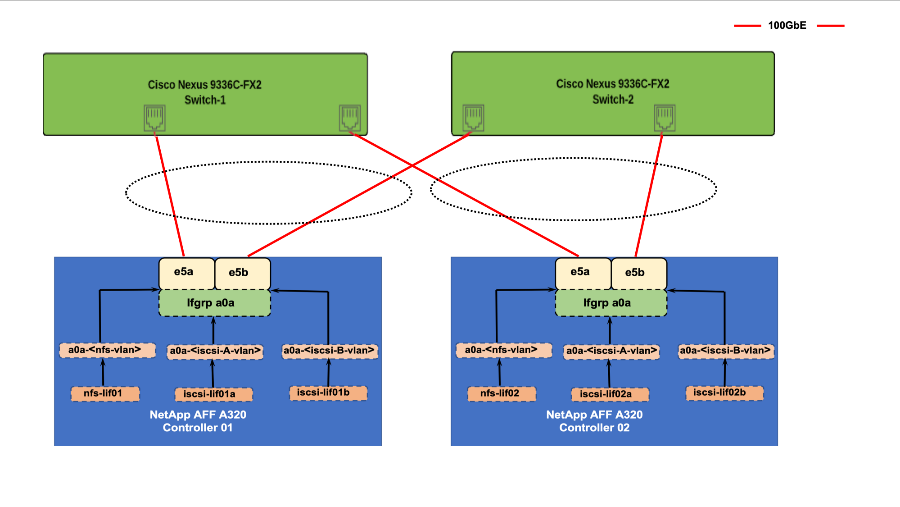
Fibre Channel (FC) Connectivity
In the FC design, the storage controller is connected to a Cisco MDS 9132T SAN switching infrastructure for FC boot and is connected to Cisco Nexus 9336C-FX2 for all Ethernet traffic. Although smaller configurations can use the direct-attached, FC/FCoE storage method of the Cisco UCS fabric interconnect, the Cisco MDS provides increased scalability for larger configurations. The Cisco MDS has multiple Cisco UCS domains and the ability to connect to a data center SAN. An ONTAP storage controller uses N_Port ID virtualization (NPIV) to allow each network interface to log in to the FC fabric using a separate worldwide port name (WWPN). This feature allows a host to communicate with a FC target network interface, regardless of where that network interface is placed. To ensure that NPIV is enabled, use the ‘show npiv status’ command on the MDS switch. Each controller can be equipped with host bus adapters (HBA) that operate at 8Gb, 16Gb, and 32Gb FC. For the FC design, the FC HBA ports operate in FC target mode and the ports are connected to two SAN fabrics. This method provides increased redundancy to make sure that the paths from the host to its storage LUNs are always available. Figure 11 shows the port and interface assignment connection diagram for the AFF storage to the Cisco MDS 9132T SAN fabrics. This FlexPod design uses the following port and interface assignments. In this design, NFS uses 100GbE and FC uses the 32Gb bandwidth.
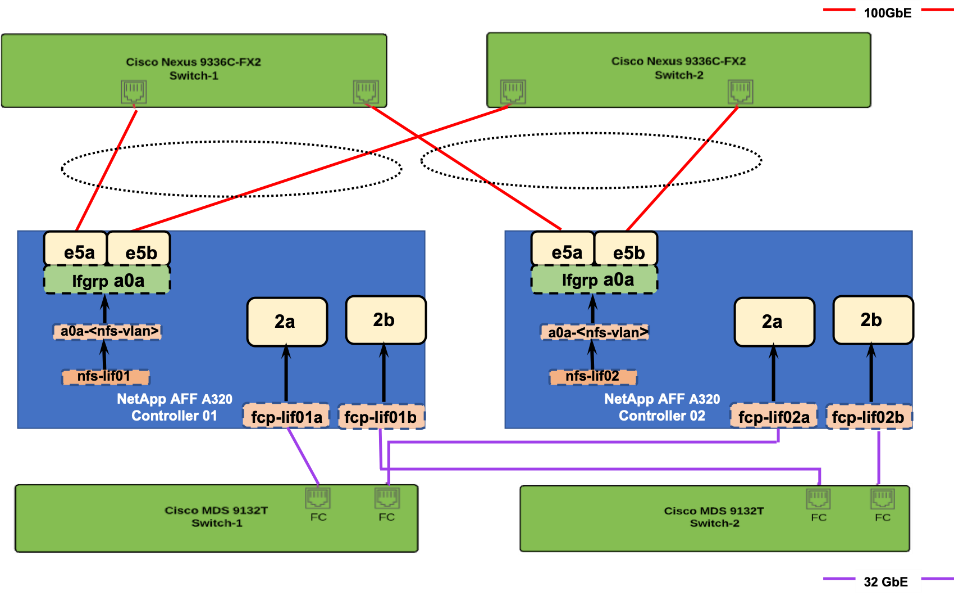
Cisco UCS Server Networking
In FlexPod, server networking generally uses the Cisco Virtual Interface Card (VIC). Other networking options are available and supported (https://www.cisco.com/c/en/us/products/interfaces-modules/unified-computing-system-adapters/index.html), but only Cisco 4th Generation VIC (1400 series) will be addressed in this section.
For Cisco UCS B-Series server networking with the Cisco UCS 6454 fabric interconnect, the current IOM choices are the new Cisco UCS 2408 Fabric Extender and the Cisco UCS 2204 and 2208 IOMs. The 2408 provides up to eight 25 GE links on each fabric to the 10/25GE ports on the 6454, while the 2204 and 2208 provide 10GE links. With the VIC 1440 and 2408, 2204 or 2208 IOMs, the Port Expander card is not supported. Figure 12 shows Cisco UCS chassis connectivity of a Cisco UCS B200 M5 server with the VIC 1440. The VIC 1440 is in the MLOM slot. Two 10GE KR lanes connect between each 2408 IOM and the MLOM slot. This combination of components provides 20GE vNICs/vHBAs, but individual network flows or TCP sessions on these vNICs have a maximum speed of 10Gbps. Multiple flows can provide an aggregate speed of 20Gbps to each IOM or 40Gbps to the server. The 2408 Fabric Extender can provide up to 200 Gbps from the servers in the chassis to each 6454 fabric interconnect.
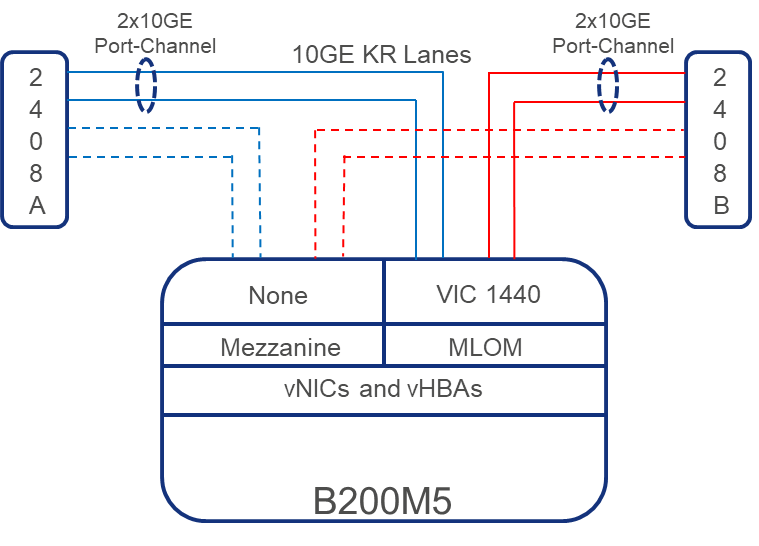
Figure 13 shows another option in Cisco UCS Chassis connectivity to a B-Series server with Cisco UCS 6454 fabric interconnects along with the Cisco UCS 2408 IOM and the VIC 1440 plus VIC1480. This combination of components provides 20GE (2x10GE) vNICs, but they can be spread across the two network cards and have two sets of physical network connections. Individual network flows or TCP sessions on these vNICs have a maximum speed of 10Gbps, but multiple flows can provide an aggregate speed of 40Gbps to each IOM or 80Gbps to the server. Note that if the 2208 IOM were used here the vNICs and flow limit would be the same, but the 2208 has up to 8 10GE links to the fabric interconnect where the 2408 has up to 8 25GE links. If the Cisco UCS 2204 IOM were used here, each server slot (MLOM and Mezzanine) would have one KR lane instead of 2, and the vNICs/vHBAs would be 10GE with a total of 40Gbps to the server.
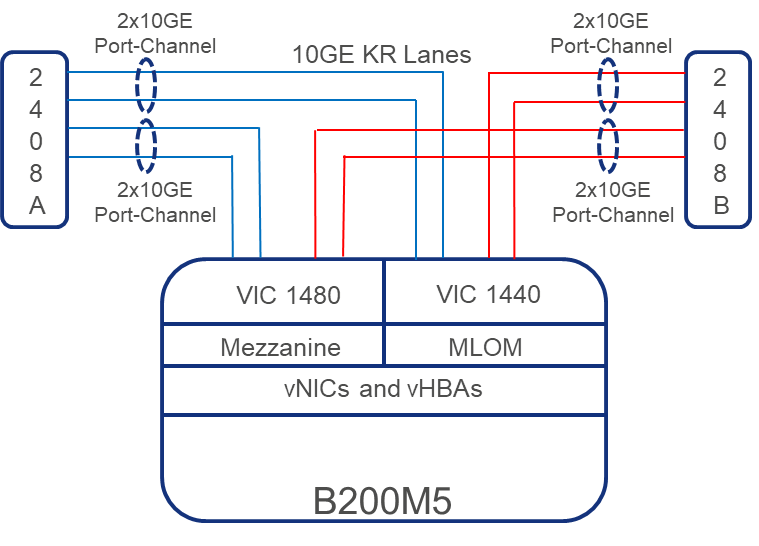
VIC 1455 and VIC 1457 are supported with Cisco UCS C-Series servers directly connected to the Cisco UCS 6454 fabric interconnects. These VICs each have four 10/25GE interfaces with up to two connecting to each fabric interconnect. The connections from the fabric interconnects to the VIC are either single link or dual link port channels. If 25GE interfaces on all four links are used, vNICs/vHBAs are 50Gbps, with an aggregate of 100Gbps to each server. Individual network flows or TCP sessions on these vNICs have a maximum speed of 25Gbps.
![]() When using VIC 1455 and VIC 1457 with Cisco UCS 6300 fabric interconnects, only single link port channels, or one 10GE connection to each fabric interconnect is supported.
When using VIC 1455 and VIC 1457 with Cisco UCS 6300 fabric interconnects, only single link port channels, or one 10GE connection to each fabric interconnect is supported.
ESXi Host Virtual Network Interface Card (vNIC) Layout
FlexPod uses a VMware Virtual Distributed Switch(vDS) for primary virtual switching, with additional Cisco UCS Virtual Network Interface Cards (vNICs) created when using Fibre Channel boot in the deployment as shown below in Figure 14.
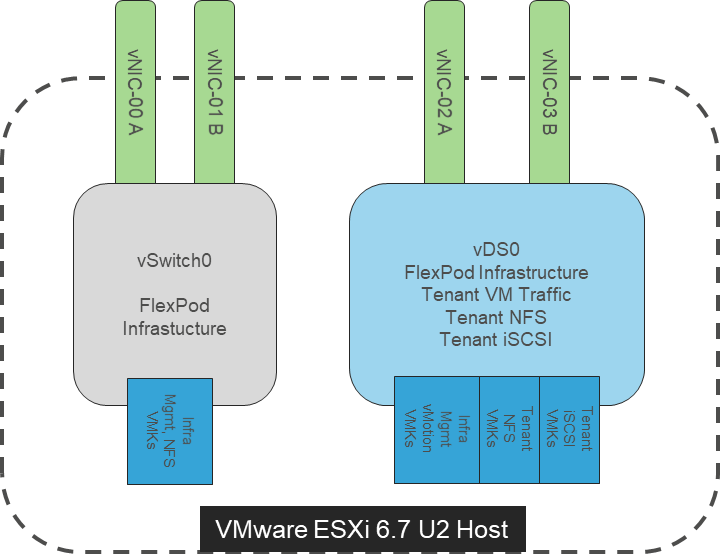
For the Fibre Channel boot implementation, 4 vNICs are defined, two for vSwitch0 and two for vDS0. vSwitch0 is defined during VMware ESXi host configuration and contains the FlexPod infrastructure management VLAN, the FlexPod infrastructure NFS VLAN, and the infrastructure vMotion VLAN. The ESXi host VMkernel (VMK) ports for management, infrastructure NFS, and vMotion (initially) are placed on vSwitch0. An infrastructure management virtual machine port group is also placed on vSwitch0 and the vCenter virtual machine’s management interface is placed here. vCenter is placed on vSwitch0 instead of the vDS because if the FlexPod infrastructure is shut down or power cycled and vCenter is attempted to be brought up on a host other than the host it was originally running on, it will boot up fine on the network on vSwitch0. If vCenter were on the vDS and moved to another host then booted, it would not be connected to the network after boot up.
The vDS contains port groups for tenant iSCSI and NFS VMKs, tenant management and virtual machine (VM) networks, and the infrastructure management network and vMotion VMKs. The vDS uplinks also have the VMware-HighTrf UCS Ethernet Adapter Policy, providing more queuing and throughput on the adapters. The vMotion VMK is migrated to the vDS when the host is added to the vDS. Placing the vMotion VMK on the vDS allows QoS to be applied to vMotion if necessary in the future. vMotion is also pinned to the switching fabric B uplink with the fabric A uplink as standby using the port group’s Teaming and Failover policy to ensure that vMotion is normally only switched in the fabric B FI. All management VMs except vCenter can be placed on the vDS. Infrastructure NFS can optionally be placed on the vDS but can be left on vSwitch0 for administrative simplicity. Tenant iSCSI port groups should be pinned to the appropriate switching fabric uplink with the other fabric uplink set as unused. Within the vDS, as additional tenants are added, port groups can be added as necessary. The corresponding VLANs will also need to be added to Cisco UCS Manager and to the vDS vNIC templates.
Additional tenant vDSs can be deployed with dedicated vNIC uplinks, allowing for RBAC of the visibility and/or adjustment of the vDS to the respective tenant manager in vCenter. Tenant networks do not have a requirement to exist in separate vDSs and can optionally be pulled into the design shown above that was used in the validation of this FlexPod release.
In the iSCSI boot implementation, an additional iSCSI boot vSwitch is added as shown in Figure 15. UCS iSCSI boot requires separate vNICs for iSCSI boot. These vNICs use the appropriate fabric’s iSCSI VLAN as the native VLAN and are attached to the iSCSI boot vSwitch as shown. Using Teaming and Failover settings, each fabric’s iSCSI VMkernel port is mapped only to the appropriate vNIC. An iSCSI boot vDS can also be used.
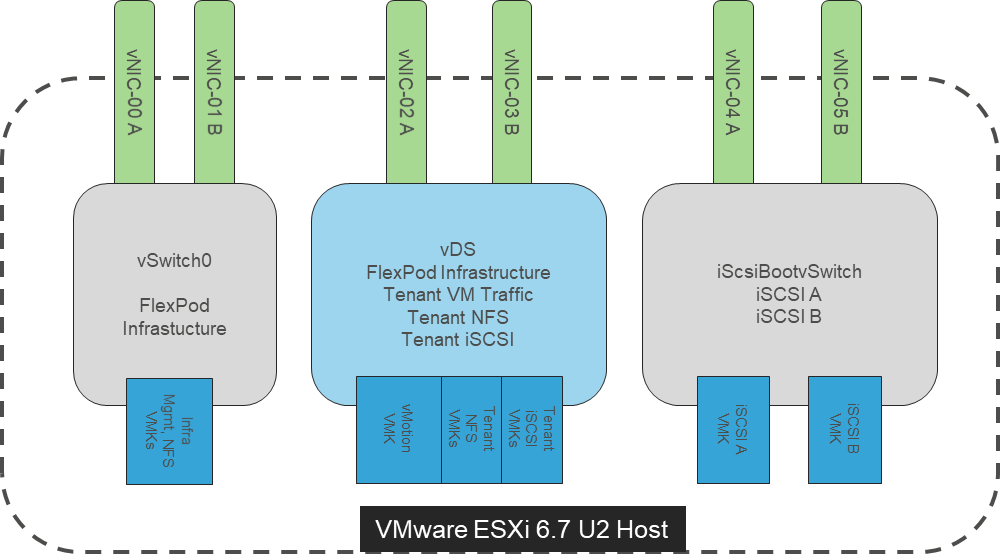
End-to-End Fibre Channel Network Connectivity
The Cisco MDS 9132T is the key component bringing together the 32Gbps Fibre Channel capabilities of the other pieces of this design. Redundant 32 Gbps Fibre Channel links extend from the MDS 9132Ts to both the storage controllers and the UCS 6454 FIs. Passage of this traffic shown in Figure 16 from left to right is as follows:
· Coming from the Cisco UCS B200 M5 server, equipped with a VIC 1440 adapter, allowing for 20Gb on each side of the fabric (A/B) into the server.
· Pathing through 10Gb KR lanes of the Cisco UCS 5108 Chassis backplane into the Cisco UCS 2208 IOM (Fabric Extender).
· Connecting from each IOM to the Fabric Interconnect with up to eight 25Gb links automatically configured as port channels during chassis association.
· Continuing from the Cisco UCS 6454 Fabric Interconnects into the Cisco MDS 9132T with a 64Gbps (2x32Gbps) SAN port channel.
· Ending at the AFF A320 Controllers with 32Gbps Fibre Channel links.
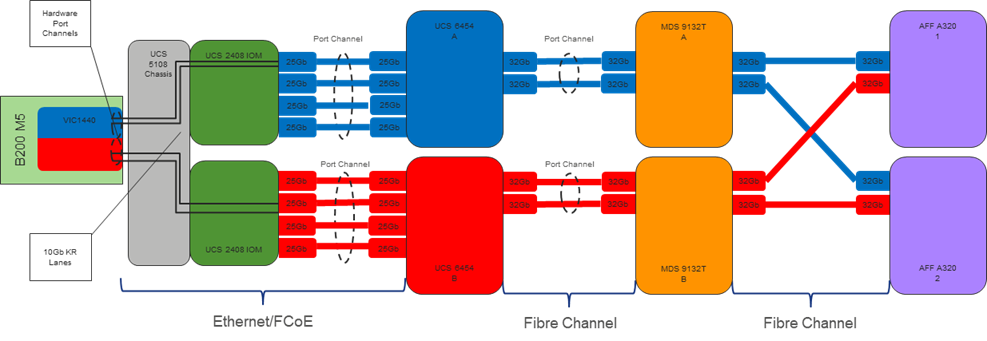
The equivalent view for a Cisco UCS C220 M5 server is shown in Figure 17. The main difference is that the two 25Gbps interfaces are connected directly between the VIC 1457/1455 and the FI and are port-channeled into a 50Gbps interface. In this case, a given FC flow is limited to 25 Gbps:
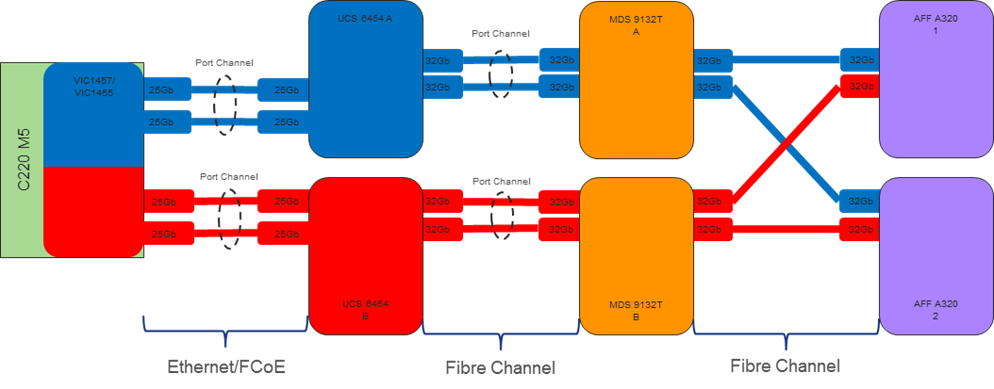
End-to-End IP Network Connectivity
The Cisco Nexus 9000 is the key component bringing together the 100Gbps capabilities of the other pieces of this design. vPCs extend to both the AFF A800 Controllers and the Cisco UCS 6454 Fabric Interconnects. Passage of this traffic shown in Figure 18 from left to right is as follows:
· Coming from the Cisco UCS B200 M5 server, equipped with a VIC 1440 adapter, allowing for 20Gb on each side of the fabric (A/B) into the server.
· Pathing through 10Gb KR lanes of the Cisco UCS 5108 Chassis backplane into the Cisco UCS 2208 IOM (Fabric Extender).
· Connecting from each IOM to the Fabric Interconnect with up to eight 25Gb links automatically configured as port channels during chassis association.
· Continuing from the Cisco UCS 6454 Fabric Interconnects into the Cisco Nexus 9336C-FX2 with a bundle of 100Gb ports presenting each side of the fabric from the Nexus pair as a common switch using a vPC.
· Ending at the AFF A 800 Controllers with 100Gb bundled vPCs from the Nexus switches now carrying both sides of the fabric.
· Although a given flow is limited to 10 Gbps, multiple flows can exhaust the available bandwidth.
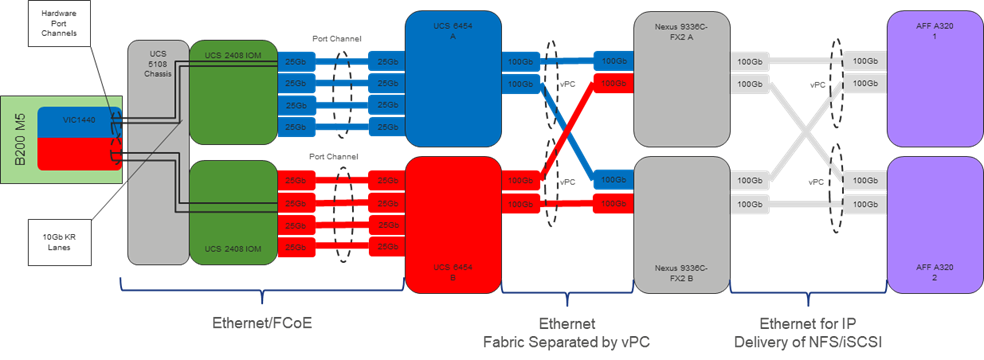
The equivalent view for a Cisco UCS C-Series server is shown in Figure 19. The main difference is that the two 25Gbps interfaces are connected directly between the VIC 1457/1455 and the FI and are port-channeled into a 50Gbps interface. In this case, a given flow is limited to 25 Gbps:
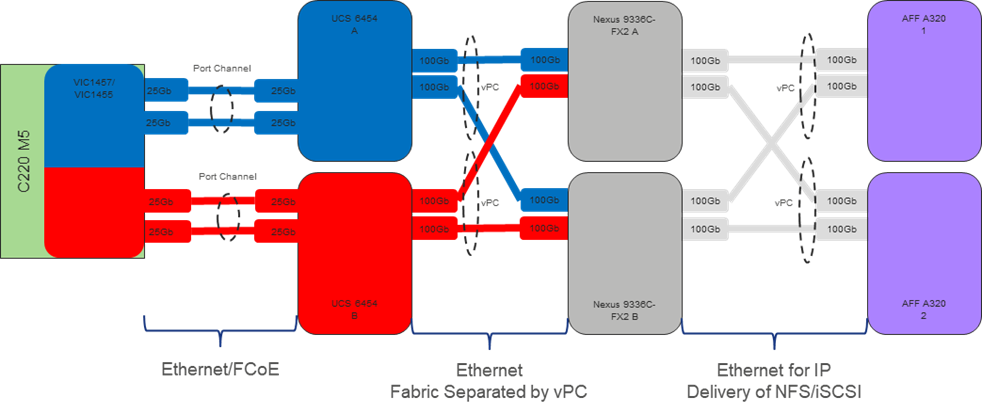
UEFI Secure Boot
This validation of FlexPod includes usage of UEFI Secure Boot for the first time. Unified Extensible Firmware Interface (UEFI) is a specification that defines a software interface between an operating system and platform firmware. Cisco UCS Manager uses UEFI to replace the BIOS firmware interfaces. This allows the BIOS to run in UEFI mode while still providing legacy support. When UEFI secure boot is enabled, all executables, such as boot loaders and adapter drivers, are authenticated by the BIOS before they can be loaded. Additionally, in this validation Trusted Platform Modules (TPMs) 2.0 were installed in the Cisco UCS B200 M5 and Cisco UCS C220 M5 servers used. VMware ESXi 6.7 Update 2 supports UEFI Secure Boot. VMware vCenter 6.7 Update 1 supports UEFI Secure Boot Attestation between the TPM 2.0 module and ESXi, validating that UEFI Secure Boot has properly taken place. Because of limitations with iSCSI boot and UEFI Secure Boot, UEFI Secure Boot was not implemented when using iSCSI boot.
A high-level summary of the FlexPod Datacenter Design validation is provided in this section. The solution was validated for basic data forwarding by deploying virtual machines running the IOMeter tool. The system was validated for resiliency by failing various aspects of the system under load. Examples of the types of tests executed include:
· Failure and recovery of FC booted ESXi hosts in a cluster
· Rebooting of FC booted hosts
· Service Profile migration between blades
· Failure of partial and complete IOM links
· Failure and recovery of FC paths to AFF nodes, MDS switches, and fabric interconnects
· Storage link failure between one of the AFF nodes and the Cisco MDS
· Load was generated using the IOMeter tool and different IO profiles were used to reflect the different profiles that are seen in customer networks
Validated Hardware and Software
Table 1 describes the hardware and software versions used during solution validation. It is important to note that Cisco, NetApp, and VMware have interoperability matrixes that should be referenced to determine support for any specific implementation of FlexPod. Click the following links for more information:
· NetApp Interoperability Matrix Tool: http://support.netapp.com/matrix/
· Cisco UCS Hardware and Software Interoperability Tool: http://www.cisco.com/web/techdoc/ucs/interoperability/matrix/matrix.html
· VMware Compatibility Guide: http://www.vmware.com/resources/compatibility/search.php
Table 1 Validated Software Revisions
| Layer |
Device |
Image |
Comments |
| Compute |
Cisco UCS Fabric Interconnects 6454, UCS 2408 Fabric Extenders, UCS B-200 M5, UCS C-220 M5 |
4.0(4g) |
Includes the Cisco UCS-IOM 2408, Cisco UCS Manager, Cisco UCS VIC 1440 and Cisco UCS VIC 1457 |
| Network |
Cisco Nexus 9336C-FX2 NX-OS |
7.0(3)I7(7) |
|
|
|
Cisco MDS 9132T |
8.4(1) |
|
| Storage |
NetApp AFF A800 |
ONTAP 9.6 |
|
| Software |
Cisco UCS Manager |
4.0(4g) |
|
|
|
Cisco UCS Manager Plugin for VMware vSphere Web Client |
2.0.5 |
|
|
|
VMware vSphere |
6.7U2 |
|
|
|
VMware ESXi nfnic FC Driver |
4.0.0.38 |
|
|
|
VMware ESXi nenic Ethernet Driver |
1.0.29.0 |
|
|
|
NetApp Virtual Storage Console (VSC) / VASA Provider Appliance |
9.6 |
|
|
|
NetApp NFS Plug-in for VMware VAAI |
1.1.2 |
|
|
|
NetApp SnapCenter Backup Management |
4.2 |
Includes the vSphere plug-in for SnapCenter |
|
|
NetApp Active IQ Unified Manager |
9.6 |
|
FlexPod Datacenter with VMware vSphere 6.7 Update 2 is the optimal shared infrastructure foundation to deploy a variety of IT workloads that is future proofed with 32 Gbps FC or 100Gbps Ethernet connectivity. Cisco and NetApp have created a platform that is both flexible and scalable for multiple use cases and applications. From virtual desktop infrastructure to SAP®, FlexPod can efficiently and effectively support business-critical applications running simultaneously from the same shared infrastructure. The flexibility and scalability of FlexPod also enables customers to start out with a right-sized infrastructure that can ultimately grow with and adapt to their evolving business requirements.
Products and Solutions
Cisco Unified Computing System:
http://www.cisco.com/en/US/products/ps10265/index.html
Cisco UCS 6454 Fabric Interconnect:
Cisco UCS 5100 Series Blade Server Chassis:
http://www.cisco.com/en/US/products/ps10279/index.html
Cisco UCS B-Series Blade Servers:
http://www.cisco.com/en/US/partner/products/ps10280/index.html
Cisco UCS C-Series Rack Mount Servers:
http://www.cisco.com/c/en/us/products/servers-unified-computing/ucs-c-series-rack-servers/index.html
Cisco UCS Adapters:
http://www.cisco.com/en/US/products/ps10277/prod_module_series_home.html
Cisco UCS Manager:
http://www.cisco.com/en/US/products/ps10281/index.html
Cisco UCS Manager Plug-in for VMware vSphere Web Client:
Cisco Nexus 9000 Series Switches:
http://www.cisco.com/c/en/us/products/switches/nexus-9000-series-switches/index.html
Cisco MDS 9000 Multilayer Fabric Switches:
Cisco MDS 9132T 32-Gbps 32-Port Fibre Channel Switch:
VMware vCenter Server:
http://www.vmware.com/products/vcenter-server/overview.html
VMware vSphere:
https://www.vmware.com/products/vsphere
NetApp ONTAP 9:
http://www.netapp.com/us/products/platform-os/ontap/index.aspx
NetApp AFF A-Series:
http://www.netapp.com/us/products/storage-systems/all-flash-array/aff-a-series.aspx
NetApp OnCommand:
http://www.netapp.com/us/products/management-software/
NetApp VSC:
http://www.netapp.com/us/products/management-software/vsc/
NetApp NFS Plug-in for VMware VAAI 1.1.2:
https://mysupport.netapp.com/documentation/productlibrary/index.html?productID=61278
NetApp SnapCenter:
https://www.netapp.com/us/products/backup-recovery/snapcenter-backup-management.aspx
Interoperability Matrixes
Cisco UCS Hardware Compatibility Matrix:
https://ucshcltool.cloudapps.cisco.com/public/
VMware and Cisco Unified Computing System:
http://www.vmware.com/resources/compatibility
NetApp Interoperability Matrix Tool:
http://support.netapp.com/matrix/
John George, Technical Marketing Engineer, Data Center Solutions Engineering, Cisco Systems, Inc.
John has been involved in designing, developing, validating, and supporting the FlexPod Converged Infrastructure since it was developed over nine years ago. Before his roles with FlexPod, he supported and administered a large worldwide training network and VPN infrastructure. John holds a Master's degree in Computer Engineering from Clemson University.
Sree Lakshmi Lanka, Solutions Engineer, Infrastructure and Cloud Engineering, NetApp
Sree is a Solutions Engineer in the Converged Infrastructure Engineering team at NetApp. She has been with NetApp since 2007, serving in a variety of Member Technical Staff- SAN Interoperability Engineering roles. Sree has over 15 years of experience in the IT industry specializing in data management, SAN and security.
Acknowledgements
For their support and contribution to the design, validation, and creation of this Cisco Validated Design, the authors would like to thank:
· Haseeb Niazi, Technical Marketing Engineer, Cisco Systems, Inc.
· Ramesh Isaac, Technical Marketing Engineer, Cisco Systems, Inc.
· Scott Kovacs, Technical Marketing Engineer, NetApp
 Feedback
Feedback